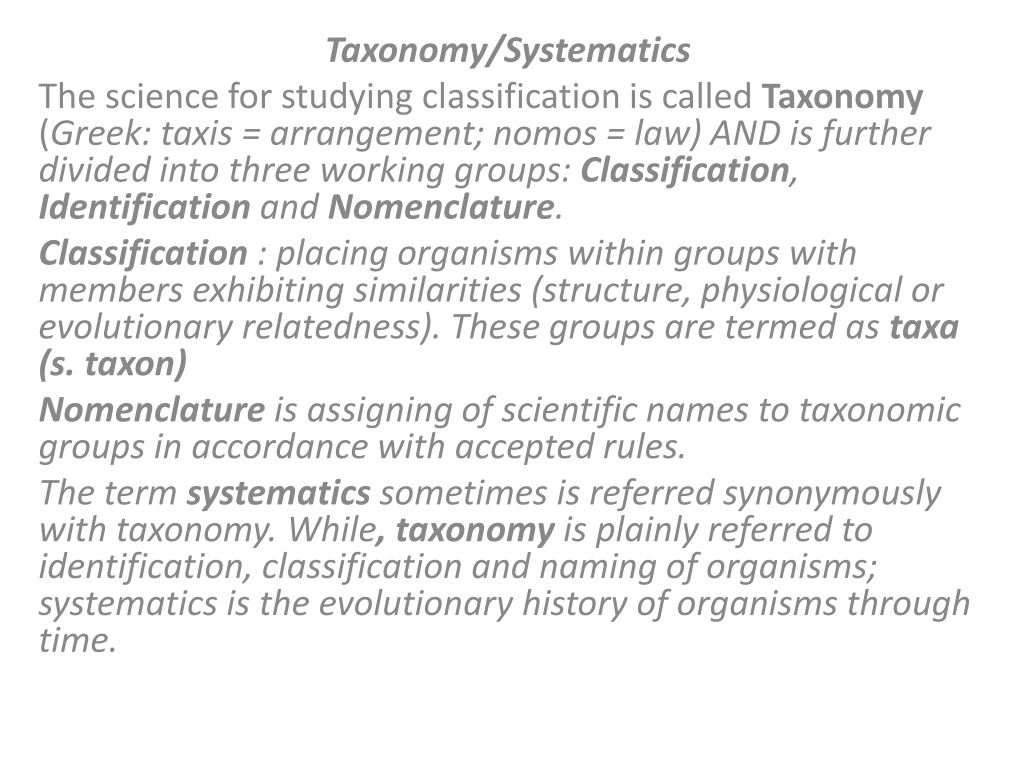Identification
The science of studying classification, Taxonomy, encompasses groups like Classification, Identification, and Nomenclature. It plays a crucial role in cataloguing species, effective communication among scientists, and evolutionary research. Binomial nomenclature ensures clarity by assigning scientific names to organisms. Explore the hierarchical structure of taxonomic ranks and the significance of Carl Woese's three kingdom classification based on rRNA sequencing. Recognize exceptions like linear chromosomes found in certain organisms.
Download Presentation

Please find below an Image/Link to download the presentation.
The content on the website is provided AS IS for your information and personal use only. It may not be sold, licensed, or shared on other websites without obtaining consent from the author. Download presentation by click this link. If you encounter any issues during the download, it is possible that the publisher has removed the file from their server.
E N D
Presentation Transcript
Taxonomy/Systematics The science for studying classification is called Taxonomy (Greek: taxis = arrangement; nomos = law) AND is further divided into three working groups: Classification, Identification and Nomenclature. Classification : placing organisms within groups with members exhibiting similarities (structure, physiological or evolutionary relatedness). These groups are termed as taxa (s. taxon) Nomenclature is assigning of scientific names to taxonomic groups in accordance with accepted rules. The term systematics sometimes is referred synonymously with taxonomy. While, taxonomy is plainly referred to identification, classification and naming of organisms; systematics is the evolutionary history of organisms through time.
The importance of taxonomy has been ever increasing. In 2000, a project called All Species Inventory was started (http://www.all-species.org/). Aim : to identify and record every species of life by 2025. Very challenging; till now 1.5 million species- identified Estimated mumber of species: between 7 to 100 million. For This mind boggling number : important of cataloguing the species in a proper and scientific way. Thus taxonomy is important for (i) effective communication among scientists about the identity of a particular microbe (ii) catalogue a large number of species in a systematic manner, (iii) help in predictions and further research about a particular isolate if little is known about it and it shows some similarities with microbes of particular group
2. Binomial nomenclature For millions of organisms, common names - lead to misunderstanding as different names are used for same organism in different places. a naming system introduced : termed scientific nomenclature . Every organism is given a binomial latin name first described by Carolus Linnaeus. The first part : genus which is followed by species. For example; humans are assigned scientific name as Homo sapiens. alwaysitalicized (Homo sapiens), where genus name starts with a capital letter. Abbreviated as H. Sapiens
Rank Example of taxonomic hierarchy Domain Eukarya Kingdom Fungi Phylum Ascomycota Class Hemiascomycetes Order Saccharomycetales Family Saccharomycetaceae Genus Saccharomyces Species cerevisiae
Carl Woeses three kingdom classification: based on rRNA sequencing
Exception: linear choromosomes found in Borrelia burgdorferi (lyme dis), Sterptomyces lividans, S. Coelicolor, Rhodococcus fascians. A. tumefaciens: one ln and one circular genome. Linear plasmids in bacteria: S. rochei, Nocardia opaca, Thiobacillus versutus
DNA Polymerases in prok. I, II, III, IV, V In eukaryotes: alpha, delta, epsilon, gamma Prokaryotes: no introns in genome Transcription and translation are coupled Polycistronic mRNA
























